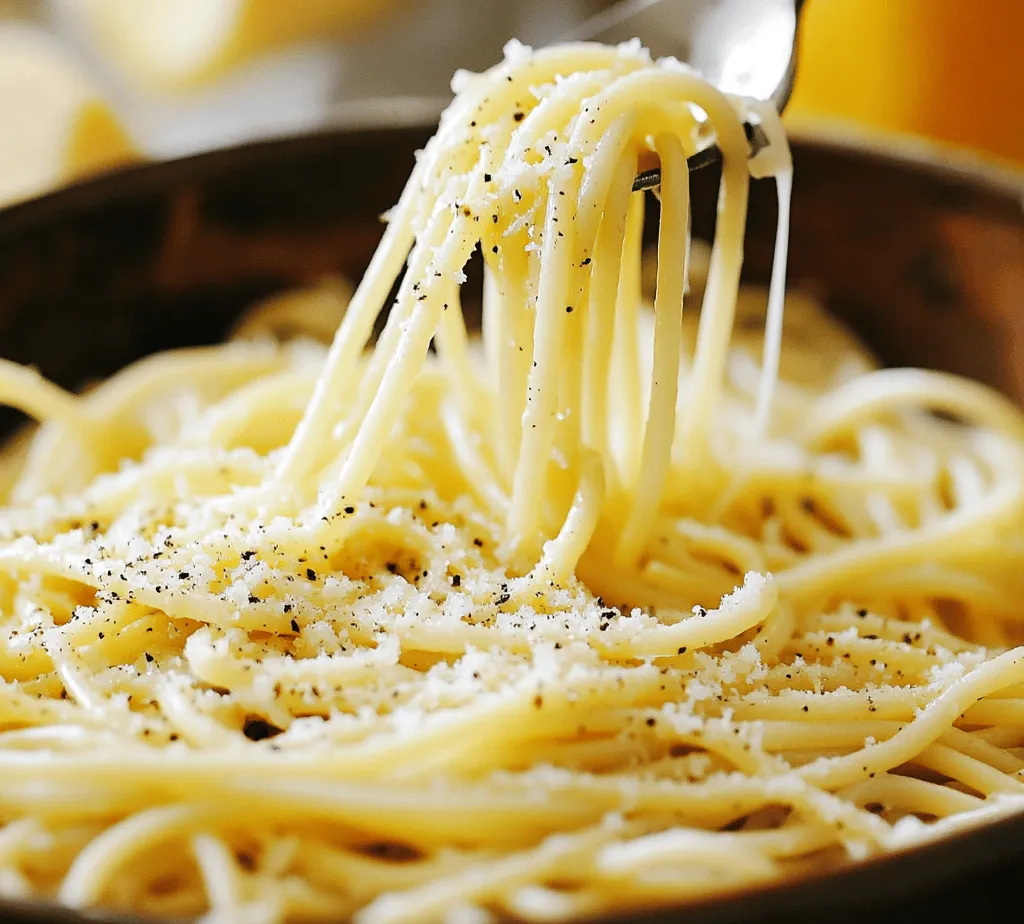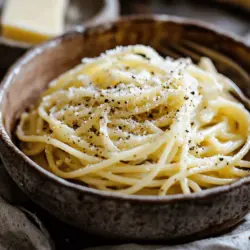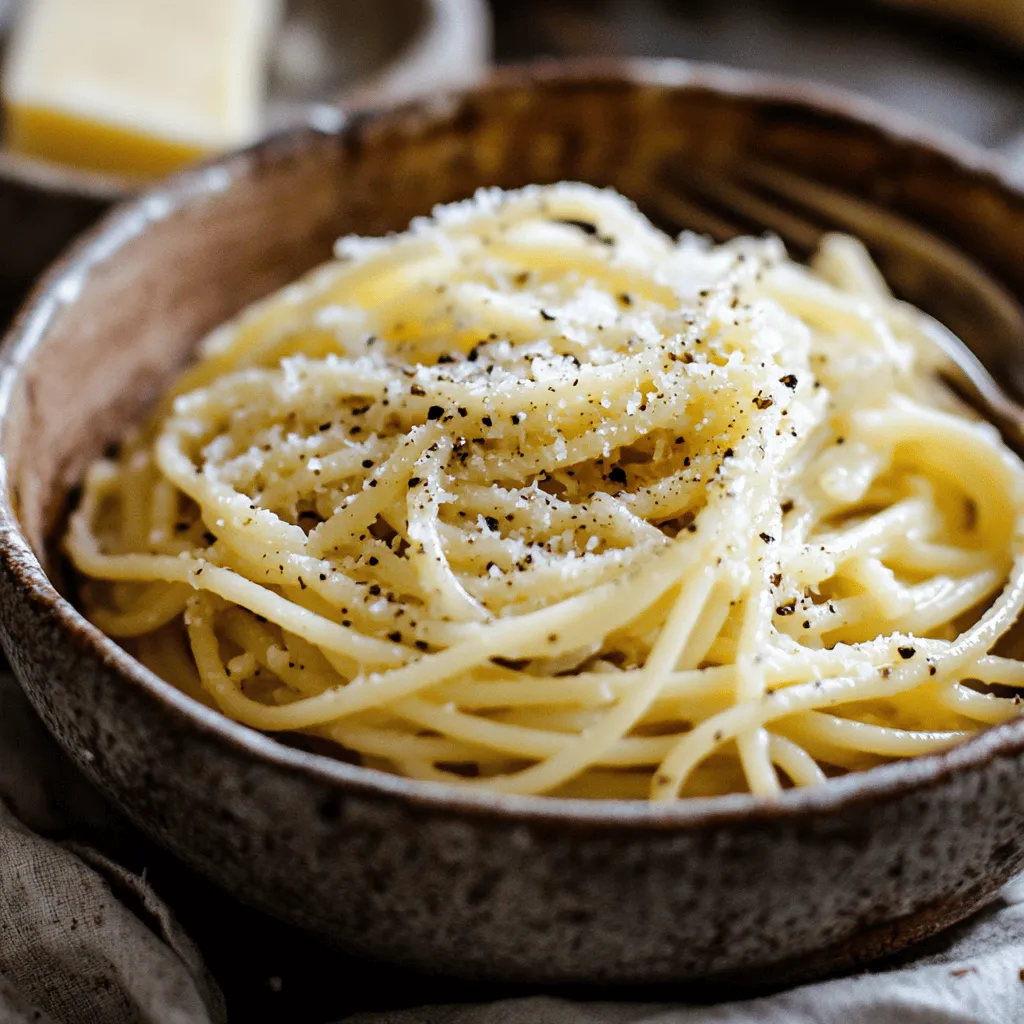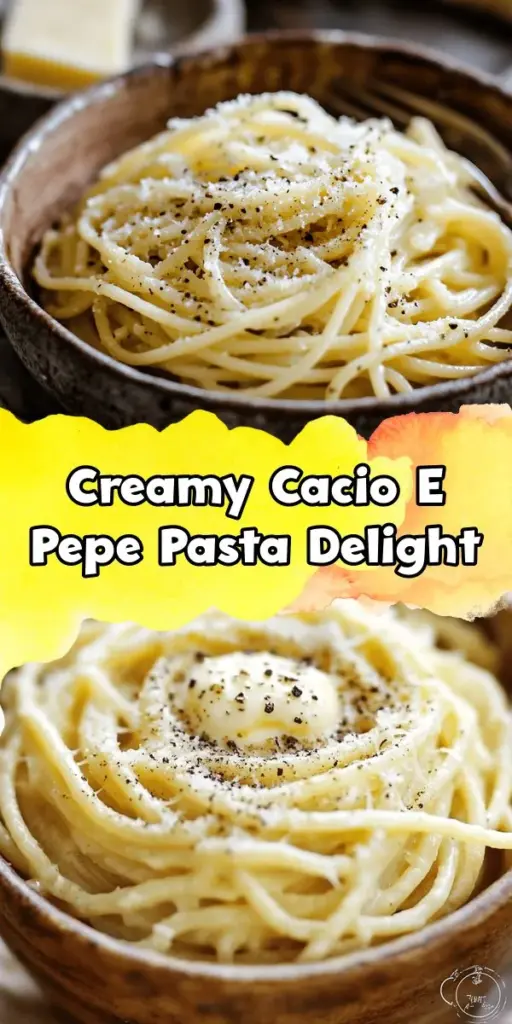Introduction
Cacio e Pepe, translating to “cheese and pepper,” is not just a dish; it’s an experience deeply rooted in the heart of Italian culinary tradition. This classic Roman pasta dish, known for its minimal ingredients yet robust flavors, has taken the culinary world by storm, earning a revered place on tables from casual family dinners to high-end restaurants. The beauty of Cacio e Pepe lies in its simplicity—where the quality of the ingredients plays a pivotal role in crafting a meal that is both satisfying and elegant.
As we embark on the journey to recreate Cacio e Pepe Delight in your own kitchen, we will explore the rich history behind this beloved dish, the essential ingredients that contribute to its unique flavor, and provide you with a step-by-step guide to mastering this iconic pasta. Whether you’re a seasoned chef or a home cook looking to expand your repertoire, this article will equip you with the knowledge and confidence to serve up a plate of Cacio e Pepe that would make any Roman proud.
The History of Cacio e Pepe
To truly appreciate Cacio e Pepe, it’s essential to delve into its origins, which trace back to the rustic kitchens of Rome. This dish embodies the philosophy of Roman cuisine—simplicity, flavor, and the use of high-quality ingredients. Historically, Cacio e Pepe was a staple for shepherds and farmers in the Lazio region, who crafted this delightful meal using easily available ingredients.
The dish’s name itself is a testament to its core components: “Cacio” refers to cheese, specifically Pecorino Romano, while “Pepe” denotes the freshly cracked black pepper that adds a distinctive kick. The simplicity of the recipe reflects the cultural narrative of Italian cooking—where less is often more, and the flavors of a few basic ingredients can create a dish that is both comforting and luxurious.
Over the years, Cacio e Pepe has transcended its humble beginnings, gaining popularity beyond Italy’s borders. Chefs and home cooks alike have embraced this dish, experimenting with various pasta types and serving styles. Yet, the essence remains the same: a celebration of cheese and pepper that highlights the beauty of Italian culinary tradition.
Ingredients Overview
Creating an unforgettable Cacio e Pepe Delight hinges on a few key ingredients that form the backbone of this dish. Let’s take a closer look at each component that contributes to its authentic flavor profile.
Pasta Selection: Spaghetti vs. Tonnarelli
When it comes to pasta in Cacio e Pepe, the choice between spaghetti and tonnarelli is crucial. While spaghetti is a classic choice, tonnarelli, a thicker, square-shaped noodle, is often preferred for its ability to hold the sauce better. The slight texture of tonnarelli creates a delightful mouthfeel, allowing the creamy cheese and pepper sauce to cling beautifully.
Regardless of your choice, ensuring that the pasta is cooked to al dente is vital. This means the pasta should have a slight bite to it, providing the perfect base for the rich sauce that will envelop it.
Pecorino Romano Cheese: The Heart of the Dish
Pecorino Romano cheese is another essential element that defines Cacio e Pepe. This hard, salty cheese made from sheep’s milk delivers a sharp and nutty flavor that enhances the overall dish. Its unique characteristics make it the quintessential cheese for this recipe. Freshly grated Pecorino is ideal, as it melts smoothly into the pasta when combined with the starchy cooking water, creating a creamy sauce that is rich yet balanced.
Freshly Cracked Black Pepper: Elevating Flavor
The addition of freshly cracked black pepper is what gives Cacio e Pepe its distinctive kick. The warmth and aromatic qualities of black pepper elevate the dish’s flavor profile, providing a beautiful contrast to the creaminess of the cheese. It’s important to use freshly cracked pepper rather than pre-ground to ensure maximum flavor and aroma.
The Role of Salt and Butter in Enhancing Taste
While the cheese and pepper are the stars of the show, salt is crucial when boiling the pasta. It helps to season the noodles and enhance their flavor, ensuring that each bite is savory. Some variations of Cacio e Pepe also incorporate a touch of butter, which can add an extra layer of richness and creaminess to the sauce, making the dish even more indulgent.
Preparation: Step-by-Step Guide
Now that we’ve covered the history and ingredients of Cacio e Pepe Delight, it’s time to dive into the preparation process. Follow these detailed steps to achieve a pasta dish that is authentic and bursting with flavor.
Boiling the Pasta: Achieving the Ideal Al Dente Texture
1. Choose Your Pasta: Begin by selecting your preferred pasta—spaghetti or tonnarelli. The choice is yours, but remember that tonnarelli offers a unique texture that many find appealing.
2. Prepare the Water: Fill a large pot with water and bring it to a rolling boil. For every liter of water, add about 10-15 grams of salt. This will ensure that the pasta is well-seasoned.
3. Cooking the Pasta: Add the pasta to the boiling water and cook according to the package instructions, typically around 8-10 minutes for spaghetti or tonnarelli. Stir occasionally to prevent sticking.
4. Testing for Doneness: To achieve the perfect al dente texture, taste the pasta a minute or two before the suggested cooking time. It should be firm to the bite but cooked through.
Toasting Black Pepper: Techniques for Maximum Flavor
1. Prepare the Pepper: While the pasta cooks, take about 2 tablespoons of whole black peppercorns and crack them using a mortar and pestle or a spice grinder. You want a mix of coarse and finer pieces to balance texture.
2. Toast the Pepper: In a dry skillet over medium heat, add the cracked black pepper. Toast it for about 1-2 minutes, stirring frequently until fragrant. This step intensifies the pepper’s flavor and adds depth to the dish.
Combining Pasta and Pepper: Ensuring Even Coating
1. Reserve Pasta Water: Before draining the cooked pasta, reserve about 1-2 cups of the starchy pasta water. This water is essential for creating a creamy sauce.
2. Mixing Pasta and Pepper: In a large mixing bowl, combine the toasted black pepper with a generous amount of the reserved pasta water. This will help to create a pepper-infused base that will coat the pasta beautifully.
3. Adding the Pasta: Drain the pasta and immediately transfer it to the bowl with the pepper mixture. Toss the pasta vigorously to ensure it’s evenly coated. The heat from the pasta will help to release the flavors of the pepper and create a wonderful base.
Creating the Sauce: The Magic of Cheese and Pasta Water
1. Incorporate the Pecorino: Gradually add freshly grated Pecorino Romano cheese to the pasta and pepper mixture. Toss continuously to encourage the cheese to melt and combine with the starchy pasta water, forming a creamy sauce. The key here is to work quickly while the pasta is still hot.
2. Adjusting Consistency: If the sauce appears too thick, gradually add more reserved pasta water until you achieve a silky, creamy consistency that clings to the pasta.
Optional Butter Finish: Enhancing Creaminess for a Richer Dish
1. Adding Butter: For those who desire an extra layer of richness, consider adding a tablespoon or two of unsalted butter to the pasta after the cheese is incorporated. This addition can lend a luxurious creaminess to the dish.
2. Final Toss: Toss everything together once more until the butter has melted and the sauce is evenly distributed throughout the pasta.
Serving Suggestions: Presentation Tips for an Elegant Meal
1. Plating the Dish: To serve, twirl the pasta onto warmed plates for an elegant presentation. The twirling motion creates a beautiful nest of pasta that is visually appealing.
2. Finishing Touches: For a final flourish, sprinkle additional grated Pecorino Romano on top, along with a few extra cracks of black pepper. This not only enhances the dish’s appearance but also elevates the flavor.
3. Accompaniments: Consider serving your Cacio e Pepe Delight with a simple arugula salad dressed with lemon vinaigrette or a glass of crisp white wine to complement the richness of the pasta.
By following these steps, you’ll create a plate of Cacio e Pepe Delight that showcases the magic of simplicity in Italian cooking. Stay tuned for more insights and variations in the upcoming sections, where we will explore tips for achieving the best results and answer common questions about this timeless dish.

Common Mistakes to Avoid
Making Cacio e Pepe Delight is deceptively simple, but there are a few common pitfalls that can affect the final outcome of this beloved Italian dish. Here are some mistakes to avoid:
1. Overcooking the Pasta: The key to perfect pasta is to cook it al dente. This means it should be firm to the bite but not hard. Overcooked pasta becomes mushy and will not hold the sauce well, resulting in a disappointing texture. Always check the pasta a minute or two before the package instructions indicate.
2. Using Pre-Grated Cheese: While it may be tempting to use pre-grated cheese for convenience, this can lead to a lack of flavor and a less-than-ideal texture. Pre-grated cheese often contains anti-caking agents that can prevent it from melting smoothly. For the best results, buy a block of Pecorino Romano cheese and grate it fresh right before using it in your dish.
3. Skipping the Toasting of Black Pepper: Toasting the black pepper is an essential step that enhances its flavor. Skipping this step can lead to a bland dish. When you toast the black pepper in the pan, it releases its essential oils, creating a more aromatic and impactful flavor that is crucial to the overall dish.
4. Incorrect Cheese-to-Pasta Ratio: The balance between cheese and pasta is vital for achieving the right creaminess and flavor intensity. If you use too little cheese, the dish may taste bland, while too much cheese can make it overly rich. A good rule of thumb is to use about 1 cup of grated cheese for every 400 grams of pasta. Adjust according to your taste, but keep this ratio in mind.
Nutritional Information
Understanding the nutritional profile of Cacio e Pepe Delight can help you make informed choices while enjoying this rich dish. Here’s a breakdown of the nutritional aspects:
- Caloric Content per Serving: A standard serving of Cacio e Pepe contains approximately 500 to 600 calories, depending on the exact amounts of cheese and pasta used.
- Macronutrient Breakdown:
- Carbohydrates: About 70 grams per serving, primarily from the pasta, which provides energy.
- Fats: Roughly 20-25 grams, mainly from the cheese, which contributes to the creaminess and richness of the sauce.
- Proteins: Around 15 grams, also derived from the cheese, making it a good source of protein for a vegetarian dish.
- Potential Dietary Considerations: Cacio e Pepe is not suitable for vegan or lactose-intolerant individuals due to the use of cheese. However, it can be adapted for vegetarians. If you’re watching your calorie intake, consider adjusting the portion sizes or using less cheese to fit your dietary needs.
Variations and Customizations
Cacio e Pepe Delight is a versatile dish that can be customized to suit various tastes and dietary preferences. Here are a few ideas to tailor the classic recipe:
- Adding Vegetables: Incorporating vegetables not only enhances the nutritional value but also adds color and texture. Consider adding peas, fresh spinach, or asparagus. These can be lightly sautéed and mixed into the pasta just before serving.
- Alternative Cheeses for Different Flavor Profiles: While Pecorino Romano is traditional, you can experiment with other cheeses. Grana Padano or Parmigiano Reggiano can offer a milder flavor, while a sharp aged cheddar might provide a unique twist.
- Incorporating Proteins: For those looking to increase the protein content, adding chicken, shrimp, or pancetta can be a delicious addition. Cook the protein separately and mix it in just before serving.
- Gluten-Free Options: If you’re following a gluten-free diet, you can use alternative pasta types made from rice, quinoa, or legume-based pasta. These options can still deliver a satisfying texture and flavor.
Pairing Suggestions
To elevate your Cacio e Pepe experience, consider these pairing suggestions that complement the dish beautifully:
- Ideal Wine Selections: A crisp white wine like Pinot Grigio or Sauvignon Blanc pairs well with the rich flavors of Cacio e Pepe. If you prefer red wine, a light Chianti can also complement the dish without overpowering it.
- Complementary Sides: A light salad with arugula and a citrus vinaigrette can balance the richness of the pasta. Additionally, serving warm, crusty bread or classic Italian antipasti like olives, cured meats, or marinated vegetables can round out your meal.
Conclusion
Cacio e Pepe Delight is more than just a meal; it embodies the essence of Italian cooking—simplicity, quality, and flavor. By mastering this recipe, you not only bring a taste of Rome into your home but also appreciate the cultural significance behind each ingredient and technique. The beauty of Cacio e Pepe lies in its ability to shine through the use of just a few high-quality ingredients, allowing you to savor each bite.
With this comprehensive guide, you are well-equipped to enjoy and share this delightful dish with friends and family. Embrace the art of making Cacio e Pepe and experience the joy of creating a classic Italian masterpiece that is sure to impress. Whether you stick to the traditional recipe or explore various customizations and pairings, Cacio e Pepe Delight will quickly become a cherished addition to your culinary repertoire. Enjoy this dish as it was meant to be enjoyed—with love, passion, and a sense of Italian heritage.


